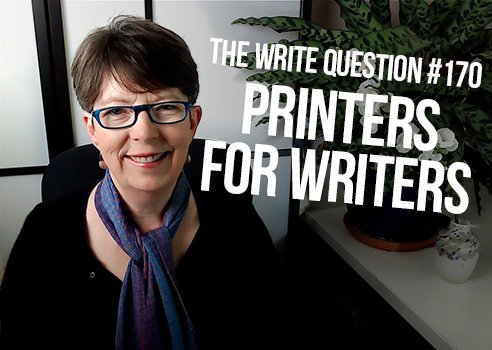Viewing time: 4 mins 49 secs
The Write Question is a weekly video podcast about writing that I started in 2017 and that ran, more or less weekly, until April 2022. This is a republication of issue #170, which addresses whether printing out text helps with editing. The post first ran on Jan. 15/21.
Transcript:
Does printing out help with editing? That’s the topic I’m addressing today in The Write Question. I’m Daphne Gray-Grant, the Publication Coach, still in pandemic mode.
I have a question from Marcelle Santos, a writer based in Rio de Janeiro, Brazil. Here’s what she’s asked by email….
“Does printing your work help you edit better? I kind of want to buy a printer, but I want to be sure it’s actually a good investment for my writing.”
Thanks for your question, Marcelle. I have some good news and some bad news for you… The good news is that I think ALL writers need printers. I can’t imagine how you can be a writer without one. So, yes, buy that printer right now.
The bad news, I’m afraid, is that it’s not likely to help with your editing. But before I get into that, let me explain what a printer WILL help you with. It will make you a much better proofreader.
Proofreading — where you are looking for problems like mistaken words, typos and spelling errors — is an important job. And it’s a hard one to do from a computer screen.
When you’re looking at a screen, light is shining INTO your eyes. This makes your eyes feel tired and it makes it much harder for you to see your own mistakes.
As well, there’s an apparent “auto-correct” in all of our brains. When we proofread, we see the word we wanted to write — rather than the one that’s actually on the page.
Here’s an example of this kind of mistake:
A few weeks later, they ship their manuscript of to their editors for some (perhaps unnecessary) polishing.
Do you see it? The word “off” is shown as “of”, with just one F. This is the kind of error that can slide by your eyeballs if you aren’t proofing a hard copy.
And while we’re talking about proofing, let me give you four other tips, in addition to printing out your document:
First, allow some time to pass after you finish writing/editing and before you proofread. Being less familiar with your work will help you catch more errors.
Second, put a ruler underneath each line as you read the text. This forces you to work much more slowly and stops your eyes from jumping ahead.
Third, start at the end of your document. Professional proofreaders often read backwards at least once. No, I don’t mean they read the words backwards. I mean, they read the last sentence first. Then the second last sentence, then the third last sentence…and so on…until they work their way back to the beginning of the document. This forces them to read each sentence in isolation – breaking the familiarity with the piece that might cause them to miss errors.
Fourth, read your work aloud at least once. You’ll catch a lot more errors this way because it will force you to read more slowly than if you were reading silently.
In the show notes below, I provide a link to a blog post I’ve written about how to become a better proofreader.
But understand that proofreading is not the same as editing. With editing, you’re addressing many issues more complicated than whether something is misspelled.
With editing, you need to make sure you’ve made your points clearly, interestingly and persuasively. Have you provided enough information? Is it all in the right order? Is it interesting enough?
I don’t believe you need a printout to answer these questions. Instead, you need time, attention and effort. Indeed, it’s usually far faster and easier to edit on screen than it is to edit on copy that’s been printed out.
This reality, however, does not negate the many benefits of printers.
Finally, let me wrap up with a quote from American lawyer and slavery abolitionist Wendell Phillips:
“What gunpowder did for war, the printing press has done for the mind.”
Marcelle, I know that an ink-jet or laser printer is a much more modest device than a printing press. But in many ways, it’s almost as revolutionary. It allows you to make instant copies! If you discover a mistake, you can fix it and print out a new version easily. And don’t ever forget the value of having a hard copy as a backup.
*
If you’d like to learn more about how to make writing a happier and more rewarding process, check out my latest book Your Happy First Draft. I don’t sell it in bookstores or via Amazon. The only place to buy it is on my website, link on the screen below and in the show notes.


